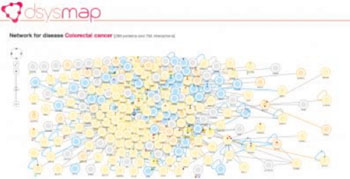Interactive Molecular Interaction Map Now Available Via Free Internet Access
By LabMedica International staff writers
Posted on 10 Mar 2015
Spanish genomic researchers have opened a site on the Internet that allows access to the latest updates that have been made to a molecular map that details the effects of mutations on protein interactions and their relation to disease development.Posted on 10 Mar 2015
The dSysMap (mapping of human disease-related mutations at the systemic level) was developed by investigators at the Institute for Research in Biomedicine (Barcelona, Spain). This analytical tool displays human disease-related mutations on the structural interactome. Mapping of mutations on protein structures and on interaction interfaces allows visualization of the region of the interactome that they affect and helps in rationalizing their mechanism of action.

Image: Example of a disease map provided by the new dSysMap system biology tool (Photo courtesy of the Institute for Research in Biomedicine, Barcelona).
An interactome is the whole set of molecular interactions in a particular cell. The term specifically refers to physical interactions among molecules but can also mean indirect interactions among genes. Mathematically, interactomes are generally displayed as graphs. Genes interact in the sense that they affect each other's function. For instance, a mutation may be harmless, but when it is combined with another mutation, the combination may turn out to be lethal. Genes that are connected in such a way form genetic interaction networks. Some of the goals of these networks are: develop a functional map of a cell's processes, drug target identification, and to predict the function of uncharacterized genes.
The interactome graph created by the investigators at the Institute for Research in Biomedicine, which was published in the February 26, 2015, online edition of the journal Nature Methods, includes more than 23,000 documented genetic mutations that affect the function of some 2,000 proteins. The Barcelona dSysMap can be accessed online free of charge (please see Related Links below), and researchers from around the world can add to it in an anonymous manner.
"We place the mutations in a global context of biological processes, which we refer to as systems biology or network biology; by doing this, we provide a more complete view of the effects of known pathological mutations," said Dr. Patrick Aloy, leader of the structural bioinformatics and network biology group at the Institute for Research in Biomedicine. "The dSysMap is a hypothesis-generating system, which, in addition, provides mechanistic details at the molecular level in order to better understand complex diseases of genetic origin—which account for most diseases—such as cancer, Alzheimer's, and diabetes. The different groups can now add the genetic mutations that they discover in the tumors to this computational tool in order to gain a more global view of their effects on the biological processes involved and to formulate new hypotheses."
Related Links:
Institute for Research in Biomedicine
dSysMap














